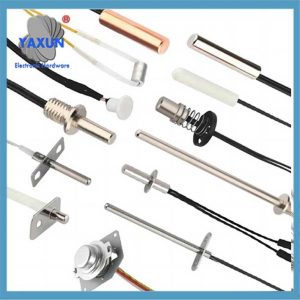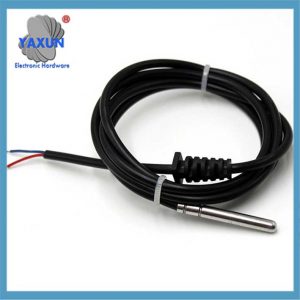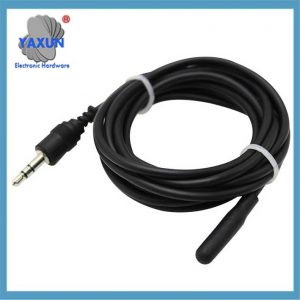NTC (음의 온도 계수) 온도 센서는 온도가 상승함에 따라 서미스터의 저항의 지수 감소를 사용하는 온도 측정 요소입니다.. 그것의 코어는 금속 산화물을 소결하여 만든 세라믹 반도체입니다. (망간과 같은, 코발트, 그리고 니켈), 그리고 온도는 저항의 변화를 측정하여 추론됩니다.. 다음은 핵심 기술 특성입니다, 애플리케이션, 그리고 선택점:
나. 핵심 특성
working 원칙 princip
온도가 올라가면, 반도체 재료의 캐리어 농도는 서지 및 저항 값이 감소합니다. (음의 온도 계수 특성).
저항 온도 관계는 Steinhart-hart 방정식을 준수합니다: r =, 여기서 B 값 (재료 상수) 민감도를 결정합니다.
작동 방식:
NTC 서머 스터는 음의 온도 계수 원리를 활용합니다, 온도가 증가함에 따라 재료의 저항이 감소하는 곳. 이 관계는 일반적으로 비선형입니다.
키 매개 변수 et
nominal 저항 (R25): 25 ° C에서의 기준 저항 (5kΩ와 같은, 10kΩ, 100kΩ).
value : 온도 감도를 반영합니다 (일반적인 3435K, 3950케이, 등.), 가치가 높을수록, 감도가 강할 수 있습니다.
시간 상수 : 응답 속도 표시기 (밀리 초에서 초).
정확성: 산업 등급은 -20 ° C ~ 85 ° C 범위에서 ± 0.1 ° C에 도달 할 수 있습니다..
구조적 특징 ural
NTC 칩으로 구성됩니다, 보호 쉘 (금속/플라스틱), 리드와 터미널, 이중층 캡슐화 프로세스를 채택하여 밀봉 및 기계적 손상에 대한 저항성을 향상시킵니다..
유연한 크기 (최소 직경 0.01 신장), 맞춤형 디자인을 지원합니다.
장점:
NTC 서머 스터는 온도 변화에 대한 높은 감도로 유명합니다., 소형 크기, 비용 효율성.
유형:
NTC 서머 스터는 다양한 형태로 제공됩니다, 칩 포함, 디스크, 그리고 멍청한 버전, 각 형태의 장점과 응용 프로그램이 있습니다.
II. 일반적인 응용 프로그램 시나리오입니다
전자 장치 및 홈 가전 제품
에어컨 및 냉장고의 온도 피드백 제어; 온수기 방지 연소 보호; 세탁기 수온 모니터링.
에너지 차량 및 에너지 저장
배터리 팩 온도 모니터링, 모터 과열 보호 (고온 저항 포장 및 강제 열 소산 설계가 필요합니다.).
산업화 제어 ial
사출 성형 기계 온도 제어, 가열 용광로 온도 교정, 전원 공급 장치 장비 과열 보호.
의료 장비
인공 호흡기 공기 흐름 온도 모니터링, 투석 장비 액체 온도 제어, 디지털 온도계.
론 필드
액체 수준 감지 (오일 탱크 오일 레벨 알람), 회로 온도 보상 (트랜지스터 드리프트 오프셋).
III. 선택 안내서
| 요인 | 기준점 |
| wemperature 범위 em | -50℃ ~ 150 0 범용; >150special 특별 포장이 필요합니다 (유리 밀봉과 같은). |
| 정확도 요구사항 | 고정밀 시나리오의 경우, B 값 일관성을 가진 모델 선택 ± 1% 및 R25 공차 ± 1% (MF53 시리즈와 같은). |
| 환경 적 적응성 | 습한/부식성 환경의 경우, 스테인레스 스틸 방수 포장을 사용하십시오 (10k3435 프로브와 같은); 진동 상황에서는 안티 벤딩 리드가 필요합니다. |
| Response 속도 onse | 빠른 응답이 필요한 경우, 열 시간 상수가있는 모델을 선택하십시오 <5에스. |
| CATCING irc | 시스템 임피던스에 따라 R25 값을 선택하십시오 (예를 들어 10kΩ는 일반적으로 5V 시스템에서 사용됩니다). |
IV. 기술 진화 방향
wementmational 혁신 ater: 골드 전극 칩은 고온 안정성을 향상시킵니다 (> 200 ℃).
완성: 사물 인터넷의 원격 모니터링을 달성하기 위해 무선 전송 모듈과 결합.
소산 최적화 : 특허받은 열 소산 구조는 전기 자동차 모터가 고온 환경에서 안정적으로 작동하도록 도와줍니다..
메모: NTC 센서는 매우 낮은 온도에서 피해야합니다 (< -50 ℃) 또는 매우 높은 온도 (300 ℃) 시나리오. 그러한 조건에 대해, 열전대를 사용하는 것이 좋습니다 (유형 k) 또는 RTD410.
 English
English Afrikaans
Afrikaans العربية
العربية বাংলা
বাংলা bosanski jezik
bosanski jezik Български
Български Català
Català 粤语
粤语 中文(简体)
中文(简体) 中文(漢字)
中文(漢字) Hrvatski
Hrvatski Čeština
Čeština Nederlands
Nederlands Eesti keel
Eesti keel Suomi
Suomi Français
Français Deutsch
Deutsch Ελληνικά
Ελληνικά हिन्दी; हिंदी
हिन्दी; हिंदी Magyar
Magyar Bahasa Indonesia
Bahasa Indonesia Italiano
Italiano 日本語
日本語 한국어
한국어 Latviešu valoda
Latviešu valoda Lietuvių kalba
Lietuvių kalba македонски јазик
македонски јазик Bahasa Melayu
Bahasa Melayu Norsk
Norsk پارسی
پارسی Polski
Polski Português
Português Română
Română Русский
Русский Cрпски језик
Cрпски језик Slovenčina
Slovenčina Slovenščina
Slovenščina Español
Español Svenska
Svenska ภาษาไทย
ภาษาไทย Türkçe
Türkçe Українська
Українська اردو
اردو Tiếng Việt
Tiếng Việt



